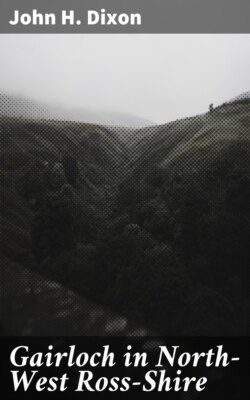Читать книгу Gairloch in North-West Ross-Shire - John H. Dixon - Страница 10
На сайте Литреса книга снята с продажи.
Appendices.
ОглавлениеTable of Contents
| A. | Genealogical Account of the MacRas, by Rev. John Macrae, who died 1704 | 395 |
| B. | Tour in Scotland by Thomas Pennant in 1772 | 396 |
| C. | Old Statistical Account of Scotland, 1792 | 399 |
| D. | Dr MacCulloch's Highlands and Western Isles of Scotland, 1811 to 1821 | 400 |
| E. | New Statistical Account of Scotland, 1836 | 403 |
| F. | Records of the Presbytery of Dingwall | 408 |
| G. | Records and Extracts relating to Sir George Hay and the Manufacture of Iron | 412 |
| H. | Addenda on St Maelrubha, and Ecclesiastical History | 415 |
| Index | 419 |
| Errata | 436 |
| Addenda | 436 |
The pronunciation is given approximately in parentheses. In many cases no combination of letters pronounced in English fashion can accurately represent the Gaelic pronunciation.
The pronunciation of ch is almost the same in Gaelic as in German. Sometimes the ch is best rendered as an aspirate only, the c being treated as if silent.
The letter c, unless followed by h, is always pronounced in Gaelic like the English k, a letter not found in Gaelic.
The Gaelic pronunciation of the letters b, d, and g is soft, and they are often sounded more as if they were p, t, and k.
In Ross-shire Gaelic sr is pronounced as if it were str, and rt as if it were rst.
The consonant d before the vowels e and i, whether followed by another vowel or not, is pronounced as if it were j.
The consonant s before the vowels i or e is sounded as sh.
The consonant l has a liquid double sound, unlike anything in English; it may be approximated by lisping the vowel u before and the letter y after the ordinary sound of the letter l.
The letter h after the consonants d, f, g, t, and s, in Ross-shire Gaelic, renders those consonants silent; bh and mh are usually pronounced like v, a letter not found in the Gaelic alphabet. Sometimes adh seems to be pronounced very like ag.
The possessive case is frequently formed in Gaelic by the insertion of the letter h after the initial consonant, and of the letter i after the vowel in the first or second syllable.
The aspirate h is often inserted between the definite article and a noun beginning with a vowel. Sometimes the letter t is similarly inserted before a noun commencing with a consonant. These, and some other changes, are made for the sake of euphony.
The vowel sounds can only be defined with difficulty. The attempts made in this glossary are but imperfect. It may be stated that ach is generally pronounced och; ao and u, as oo; ea, as a in "bake"; a, e, and i, usually as in French; ei, sometimes as a in "bake," and sometimes as i in "bin"; and ai is sometimes almost like u in "dull," and sometimes like a in "tan."
Anyone desiring to pronounce a Gaelic name or word correctly, should ask a native to render it, and try to imitate him; even then, in some cases, it will be impossible to be exactly right.
